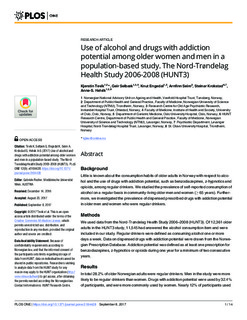| dc.contributor.author | Tevik, Kjerstin Elisabeth | |
| dc.contributor.author | Selbæk, Geir | |
| dc.contributor.author | Engedal, Knut | |
| dc.contributor.author | Seim, Arnfinn | |
| dc.contributor.author | Krokstad, Steinar | |
| dc.contributor.author | Helvik, Anne-Sofie | |
| dc.date.accessioned | 2018-09-20T13:17:58Z | |
| dc.date.available | 2018-09-20T13:17:58Z | |
| dc.date.created | 2017-09-20T13:19:29Z | |
| dc.date.issued | 2017-09 | |
| dc.identifier.citation | PLoS ONE. 2017, 12 (9):e0184428, DOI: http://dx.doi.org/10.1371/journal.pone.0184428 | nb_NO |
| dc.identifier.issn | 1932-6203 | |
| dc.identifier.uri | http://hdl.handle.net/11250/2563722 | |
| dc.description.abstract | Background Little is known about the consumption habits of older adults in Norway with respect to alcohol and the use of drugs with addiction potential, such as benzodiazepines, z-hypnotics and opioids, among regular drinkers. We studied the prevalence of self-reported consumption of alcohol on a regular basis in community-living older men and women (≥ 65 years). Furthermore, we investigated the prevalence of dispensed prescribed drugs with addiction potential in older men and women who were regular drinkers. Methods We used data from the Nord-Trøndelag Health Study 2006–2008 (HUNT3). Of 12,361 older adults in the HUNT3 study, 11,545 had answered the alcohol consumption item and were included in our study. Regular drinkers were defined as consuming alcohol one or more days a week. Data on dispensed drugs with addiction potential were drawn from the Norwegian Prescription Database. Addiction potential was defined as at least one prescription for benzodiazepines, z-hypnotics or opioids during one year for a minimum of two consecutive years. Results In total 28.2% of older Norwegian adults were regular drinkers. Men in the study were more likely to be regular drinkers than women. Drugs with addiction potential were used by 32.4% of participants, and were more commonly used by women. Nearly 12% of participants used benzodiazepines, 19% z-hypnotics and 12.4% opioids. Among regular drinkers, 29% used drugs with addiction potential, which was also more common among women. Adjusted for age, gender and living situation, use of z-hypnotics was associated with regular alcohol intake, while use of opioids was associated with no regular alcohol intake. Conclusion The prevalence of the use of drugs with addiction potential was high in a Norwegian population of older adults who reported regular consumption of alcohol. Strategies should be developed to reduce or prevent alcohol consumption among older adults who use drugs with addiction potential. | nb_NO |
| dc.description.abstract | Use of alcohol and drugs with addiction potential among older women and men in a population-based study. The Nord-Trøndelag Health Study 2006-2008 (HUNT3) | nb_NO |
| dc.description.sponsorship | This project has been made possible by the Norwegian Extra Foundation for Health and Rehabilitation (https://www.extrastiftelsen.no/) through The Norwegian Council for Mental Health (http://www.psykiskhelse.no/) (2015/FO5044). In addition, the project has been funded partly by the Norwegian National Advisory Unit on Ageing and Health, Vestfold Hospital Trust (http://www. aldringoghelse.no/). KT is a phd-fellow in this project and she received the funding. The funders had no role in study design, data collection and analyses, decision to publish, or preparation of the manuscript. | nb_NO |
| dc.language.iso | eng | nb_NO |
| dc.rights | Navngivelse-Ikkekommersiell-DelPåSammeVilkår 4.0 Internasjonal | * |
| dc.rights.uri | http://creativecommons.org/licenses/by-nc-sa/4.0/deed.no | * |
| dc.title | Use of alcohol and drugs with addiction potential among older women and men in a population-based study. The Nord-Trøndelag Health Study 2006-2008 (HUNT3) | nb_NO |
| dc.title.alternative | Use of alcohol and drugs with addiction potential among older women and men in a population-based study. The Nord-Trøndelag Health Study 2006-2008 (HUNT3) | nb_NO |
| dc.type | Journal article | nb_NO |
| dc.type | Peer reviewed | nb_NO |
| dc.description.version | publishedVersion | nb_NO |
| dc.rights.holder | © 2017 Tevik et al. This is an open access article distributed under the terms of the Creative Commons Attribution License, which permits unrestricted use, distribution, and reproduction in any medium, provided the original author and source are credited. | nb_NO |
| dc.source.volume | 12 | nb_NO |
| dc.source.journal | PLoS ONE | nb_NO |
| dc.source.issue | 9 | nb_NO |
| dc.identifier.doi | 10.1371/journal.pone.0184428 | |
| dc.identifier.cristin | 1495853 | |
| cristin.unitcode | 1991,9,1,0 | |
| cristin.unitname | Avd Alderspsykiatri | |
| cristin.ispublished | true | |
| cristin.fulltext | original | |
| cristin.qualitycode | 1 | |

